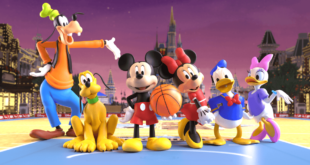The NBA’s Utah Jazz opened their preseason slate on Friday night against a barnstorming New Zealand team called the Breakers. The night before, Jazz owner Ryan Smith was on the other side of the world, in a hotel room in Scotland, to play in a pro-am golf tournament. That might seem like a poorly timed trip, what with Smith’s latest toy, Utah Hockey Club, set to make its franchise debut in mere days. But back when the trip was planned, Utah Hockey Club didn’t exist, and the idea of it existing in the fall of 2024 was, frankly, preposterous.
While Smith hit the links, his crew back in Salt Lake City was hard at work, scrambling to meet a seemingly impossible deadline.
So, you know, its normal state.
“We redid our (basketball) locker rooms, too, as we went through all this,” Smith said from Scotland that night. “The team’s working all night. They’re still working. I bet if I walked in there, it wouldn’t look like it was ready. But by tomorrow, somehow, it will be.”

GO DEEPER
NHL season previews 2024-25: Projecting each team from worst to first
Somehow, it will be. The Utah Hockey Club doesn’t have a nickname yet — the Yetis seems to be the front-runner — but that could certainly be its slogan. Hockey, in Utah? Somehow, it will be. An NHL-caliber facility wedged into the basketball-only Delta Center? Somehow, it will be. A team, a home, a practice facility, an identity and a culture rising from the ashes of the Arizona Coyotes in just a few months? Somehow, it will be.
And somehow, it is. On Tuesday night, in front of perhaps 16,000 fans — up to 5,000 of whom will have paid for the privilege of not even being able to see one of the goals thanks to the quirks of the arena — Utah Hockey Club will step onto the ice at Delta Center in its home blues and become the 53rd incarnation of a National Hockey League team, a five-month-old franchise hosting the 98-year-old Chicago Blackhawks.
The way Smith and his team sell it, it’ll look like NHL hockey in an NHL rink. Somehow, it will be. It’ll also look like a deliberately planned, well-thought-out, carefully executed and plotted long-term plan come to fruition.
It was anything but. The frantic, mad scramble to create the Utah Hockey Club is unlike anything the modern NHL, and maybe the modern North American pro sports landscape, has seen.
NHL commissioner Gary Bettman had a simple question for Smith, and he didn’t want any qualifiers, no hems or haws. There was no time for uncertainty, no time for maybes.
Can you do it, yes or no?
Smith said yes. And he believed it. Well, mostly.
“You can believe it, but until you see it and you know what’s going to happen, that’s the work,” Smith said.
It was mid-April, and the Coyotes were wrapping up their second season in 4,600-seat Mullett Arena, a beautiful but embarrassingly small rink on the campus of Arizona State University that served as a lifeboat for the franchise as it sought a new arena in the greater Phoenix area after getting booted from its longtime digs in not-so-nearby Glendale. Years of mismanagement and cheap and ineffective ownership had turned the Coyotes into the laughingstock of the sporting world, and Bettman — who had for so long clung to the 11th-largest media market in the country — was finally ready to pull the chute.
Smith, the 46-year-old billionaire owner of the Jazz and MLS’ Real Salt Lake, had already expressed interest in an expansion team. Bettman offered him something a little more immediate: the Coyotes. Like, now. How long did Smith get to think about it?
“A day?” he said with a laugh. “It was April 18 that we flew down because there was a lot that had to be figured out. We knew it was a possibility before that, but there are a lot of possibilities in sports that just never turn out. Gary asked if we could do it, and we said, ‘Yes, we’re going to figure it out.’”
Just like that, the Coyotes and their branding and their history were put in storage for a future owner and a future arena. And on that same day, April 18, Smith walked into a room and told about 70 people they had essentially been traded to Utah. Smith introduced himself and his wife, Ashley, along with now-president of hockey operations Chris Armstrong, and tried to convince the shell-shocked team and staff that being uprooted from one of the most desirable places to live in the NHL and sent to an unfamiliar city with no hockey history was indeed a good thing for them.
Then Smith had a better idea.
“I just said, ‘Let’s go golf,’” he recalled. “‘You’re hockey players, let’s go golf.’”
Eighteen holes later, the ice and the tension broken and the mental fog lifting, Smith gathered the players and staff and asked them a simple question: What do you need?
“He asked us what we wanted that we hadn’t had in the past,” said forward Lawson Crouse, a veteran of eight Coyotes seasons. “Just sat us down after golf and hit us with that. We were all taken off guard. We didn’t really know what to say.”

GO DEEPER
What is the Utah Hockey Club, and how did the NHL get here?
You couldn’t blame the players, after all they’ve been through with other owners, if they were skeptical or thought it was a trap — a way to weed out the whiners and the prima donnas. But pretty quickly, it all spilled out. They needed better hotels. Better flights. Better food. More of a scientific focus on recovery. All the little things that allow a professional athlete to be at their best, physically and mentally.
On the way home, Smith called up his contact at Delta, the Jazz’s main corporate partner, and laid out the players’ travel needs. Just like that, the work had begun.
“And everything we asked for, they did,” Crouse said. “And then some.”
Six days later, more than 12,000 fans welcomed the players to Delta Center for a raucous pep rally, which Crouse called “one of the coolest hockey experiences I’ve had.” Crouse and new captain Clayton Keller took to the mic to hype up the crowd. Veteran center Liam O’Brien told the crowd they could call him “Spicy Tuna,” and teammate Jack McBain led them in a “Spicy Tuna” chant. Earlier, hundreds of youth hockey players had greeted the erstwhile Coyotes at the airport.
They had fans, yes. But they didn’t have a name. They didn’t have jerseys. They didn’t have apartments.
They didn’t even have a locker room. But the team at Smith Entertainment Group was already working on that.
“We were already in demolition stages at that time,” said Jim Olson, president of the Jazz and the man given the seemingly impossible task of getting Delta Center ready for hockey by the end of the summer. “If you would have walked in then, it was just demolition and a complete disaster. We showed them the general area, but we didn’t take them behind the walls. It was a disaster. It wasn’t anything near ready.”
Yet somehow, it would be.
The fear around the NHL — a perfectly reasonable fear — is that Delta Center is going to be Barclays Center 2.0. That it’ll be an awkward fit, a poor venue for hockey, with huge swaths of seats unable to see the full sheet of ice. Yet another inferior, embarrassing situation for these players to deal with. The New York Islanders escaped crumbling Nassau Coliseum for shiny Barclays Center in Brooklyn in 2015 and promptly signed a 25-year lease. Five years later, they slinked back to the Coliseum until the new UBS Arena could be built.
Everything about Barclays was wrong — the seats that didn’t face the rink, the seats that couldn’t see one of the goals, the much-mocked SUV behind the glass in one corner. There was no press box in the early days, with fans peering over reporters’ shoulders as they wrote at folding tables in the corner. The locker rooms were bare bones. And the scoreboard hung not over center ice, but over one of the blue lines.
Mullett Arena was comically small, and players had to walk outside to get to their locker rooms, but it was a spectacular place to watch a game. It was unique in the pro sports world and had a certain charm. Unacceptable as Mullett was, for those who lived through the Islanders’ Brooklyn era, it was conceivable that Delta Center actually could be a step down.
Well, here’s some good news: The scoreboard is in the correct spot at Delta Center.
“Directly over center ice,” Olson said with a laugh. “To the centimeter.”

Delta Center has about 5,000 obstructed-view seats. (Jamie Sabau / Getty Images)
Delta Center is not perfect. Not by a long shot. Five thousand obstructed view seats is an awful lot, and 11,000 normal seats is terribly insufficient. But the club is fortunate that it’s not one of those old rinks wedged into a couple of square city blocks. It’s a sprawling building with room (and rooms) to spare.
But it’s how Olson and his crew are using that space that is most encouraging.
No NHL regulation mandates that teams have to have hallways that connect the locker rooms to the benches. There are several rinks around the league in which players have to enter the ice surface from the corners, not from the benches. Madison Square Garden, one of the most universally beloved arenas, is one of them. And when Salt Lake City hosted a Los Angeles Kings preseason game in the past, Delta Center made do with a quickly retrofitted auxiliary locker room and the corner entrance. It was good enough.
But Smith and Olson don’t like the way that looks. It’s not “first class,” in their minds. And good enough was no longer good enough.
So rather than save a lot of time and money by rerouting teams to the Zamboni entrances, they completely reconfigured the bowels of the arena, gutting and moving the cash-cow courtside suites (“bunker suites,” in arena parlance) to build direct-access tunnels from the locker rooms to the benches. And that was just the start. They had to build new training areas, new medical areas, new dining areas and a new players’ lounge. They needed to build street lockers for the civilian clothes and hockey lockers for all the gear. They had to find a temporary practice facility at the Olympic Oval in nearby Kearns while simultaneously building a brand-new practice facility that has to be ready by next fall’s training camp.
They had to think of all the little details, too, like a place for the equipment staff to sharpen skates and for players to blowtorch and shape their stick blades. They had to rethink the arena lighting because the reflection off the bright white ice is different than the shine of an NBA hardcourt. They had to create new broadcast locations, address sound issues, tweak some seating. The list seemed endless, and while demolition happened quickly, the construction didn’t start for another month or two.
“We did all that in four months,” Olson said, chuckling at the absurdity of it.
In the long term, the plan is to reconfigure the extremely steep basketball-centric seating to eliminate the obstructed-view seats and increase the capacity. But Utah didn’t have the time or the mental bandwidth to think about that over those frantic few months leading to opening night.
It helped that the 33-year-old Delta Center had been renovated in 2017, so Smith Entertainment Group was able to bring back the same architect and the same contractor. The crew knew what walls were load-bearing, where extra space could be found and how to fit everything without cutting any corners. And as opening night approaches, it’s all just about ready to go.
Somehow.
“It’s all world-class,” said Smith, who equated the time crunch to a new company’s initial public offering or a tech launch. “They started in July. Everyone’s like, ‘Oh, you started in April.’ No, no, no, no. The first month or two was all about the players, the team and the personnel, getting them to Utah, helping them find rental units, all of that. How do we make sure that transition is good? Because nothing else matters if that doesn’t work.”
Ray Ferraro already had been in the NHL for 16 seasons by the time the Atlanta Thrashers plucked him in the 1999 expansion draft. He had seen it all by then. But when the time came for the Thrashers to debut, Ferraro was adamant about taking the opening faceoff. A quarter century later, he still has a framed photo of that draw, taken from high above the rink.
“You want to be part of something new, the first,” he said. “For those players that have slogged through the mud in Arizona for a couple years, this is all great. It’s all brand new. The owner has spent money quickly. The excitement around the building and the building rehab that’s going to happen, it’s really fun and it’s a different start to the season for every one of those guys.”
The truth is, it’s been every bit as chaotic for the players as it’s been for the ownership group these past six months. Those who had to uproot their families needed to find new homes, find new schools, find new sports teams for their kids. Heck, Crouse had to buy a house and move in earlier than everyone else, on July 15, because he and his partner had a baby on the way. Most of the Coyotes lived in the Scottsdale area, and for all the nonsense and failures of the franchise, it was a fabulous lifestyle, with good weather and good golf all year long. Being sent, essentially against their will, to another city was jarring, to say the least.
But as the summer progressed, the excitement quickly dwarfed the stress.
“Obviously, there was a lot going on in Arizona that was out of the players’ control,” Crouse said. “We did our best to block out the surrounding noise. But now, the excitement level is so high. Our room, our facilities are all top-notch. Credit to them. They had five or six months to get all this done and they’ve done it all so seamlessly. Just blown away.”

Lawson Crouse on Utah Hockey Club ownership: “Credit to them. … Just blown away.” (Ezra Shaw / Getty Images)
The buzz in Salt Lake City is real. Delta Center was packed for the preseason debut against the Kings on Sept. 23, and it was so loud that Crouse said it got the team “10 times more excited than we already were.” Smith noticed with glee that Keller and Nick Schmaltz were tapping each other on the pads, slack-jawed, after they first stepped onto the ice, and that goalie Connor Ingram was looking around and soaking it all in.
“We’re all going through this experience for the first time together, and there’s a spirit about it,” Smith said. “There truly is.”
That buzz is boosted by the fact that Utah might be pretty darn good this season. Under general manager Bill Armstrong (no relation to Chris, the president of hockey operations), the Coyotes had steadily been building a solid team. That rebuilding process was supercharged once Smith took over, with Utah trading for defensemen Mikhail Sergachev (from the Tampa Bay Lightning) and John Marino (from the New Jersey Devils) minutes apart during the second round of the NHL Draft in Las Vegas. Utah could be in the mix for a playoff spot in its first season.
The Jazz, meanwhile, have welcomed their new co-tenants with open arms. Finnish star forward Lauri Markkanen stayed to watch the entire preseason opener, and Smith said point guard Collin Sexton can’t wait to sit on the glass. Smith said that every Jazz player will be there on opening night against Chicago.
Six months ago, Utah Hockey Club didn’t even exist. The club is still waiting on a few pieces of furniture, still putting the finishing touches on the paint job, still scurrying to accommodate ESPN’s multiple sets, still in the scramble mode it’s been in nonstop since the franchise’s sudden inception. But on Tuesday night — with brand-new locker rooms and brand-new training rooms and brand-new tunnels and brand-new branding and thousands of brand-new fans — it will be ready to host its first regular-season game before a national television audience.
Somehow, it will be.
“It’s incredible what they’ve done here,” Crouse said. “From the first time meeting them, it’s clear that they care. They care about the hockey. I think that’s what makes them so special. It’s only been about five months, but you can’t have a bad thing to say about any of it. We built a great culture in Arizona with our staff and our players. To be able to transfer that to Utah and have ownership believe in that, too, it’s just amazing. All of this is just amazing.”
(Illustration: Meech Robinson / The Athletic; Photos: Ezra Shaw, Chris Gardner / Getty Images)
Source link
 meganwoolsey Home
meganwoolsey Home



